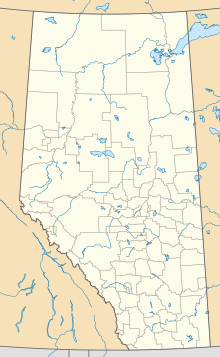Robb, Alberta
Robb | |
|---|---|
Location of Robb in Alberta | |
| Coordinates: 53°14′00″N 116°58′43″W / 53.2333°N 116.9786°W | |
| Country | |
| Province | |
| Census division | No. 14 |
| Municipal district | Yellowhead County |
| Government | |
| • Type | Unincorporated |
| • Mayor | Jim Eglinski |
| • Governing body | Yellowhead County Council
|
| Area | |
| • Total | 6.83 km2 (2.64 sq mi) |
| Elevation | 1,140 m (3,740 ft) |
| Population (2016)[1] | |
| • Total | 170 |
| • Density | 25/km2 (64/sq mi) |
| • Dwellings | 82 |
| Time zone | UTC-7 (MST) |
Robb is a hamlet in west-central Alberta, Canada within Yellowhead County.[2] It is located on Highway 47, approximately 53 kilometres (33 mi) southwest of Edson. It has an elevation of 1,140 metres (3,740 ft).
It was named after Peter Addison Robb (1887-1955), a Dominion Land Surveyor, freighter and prospector.[3]
Statistics Canada recognizes Robb as a designated place.[4]
The hamlet is located in census division No. 14 and in the federal riding of Yellowhead.
Demographics
As a designated place in the 2016 Census of Population conducted by Statistics Canada, Robb recorded a population of 170 living in 82 of its 111 total private dwellings, a change of -0.6% from its 2011 population of 171. With a land area of 6.83 km2 (2.64 sq mi), it had a population density of 24.9/km2 (64.5/sq mi) in 2016.[1]
In the 2011 Census, Robb had a population of 171 living in 78 of its 85 total dwellings, a -8.1% change from its 2006 population of 186. With a land area of 6.8 km2 (2.6 sq mi), it had a population density of 25.15/km2 (65.1/sq mi) in 2011.[4]
Climate
| Climate data for Robb | |||||||||||||
|---|---|---|---|---|---|---|---|---|---|---|---|---|---|
| Month | Jan | Feb | Mar | Apr | May | Jun | Jul | Aug | Sep | Oct | Nov | Dec | Year |
| Record high °C (°F) | 16.7 (62.1) |
19 (66) |
18 (64) |
28 (82) |
32 (90) |
32.2 (90.0) |
32.2 (90.0) |
32.2 (90.0) |
33 (91) |
27 (81) |
17.8 (64.0) |
15.5 (59.9) |
33 (91) |
| Mean daily maximum °C (°F) | −2.8 (27.0) |
−0.8 (30.6) |
3.9 (39.0) |
10.9 (51.6) |
15.8 (60.4) |
19.3 (66.7) |
21.5 (70.7) |
20.8 (69.4) |
16.2 (61.2) |
11.1 (52.0) |
1.4 (34.5) |
−2.9 (26.8) |
9.5 (49.1) |
| Daily mean °C (°F) | −9.6 (14.7) |
−7.9 (17.8) |
−3.2 (26.2) |
3.7 (38.7) |
8.3 (46.9) |
12 (54) |
14.2 (57.6) |
13.5 (56.3) |
9.1 (48.4) |
4.1 (39.4) |
−4.9 (23.2) |
−9.2 (15.4) |
2.5 (36.5) |
| Mean daily minimum °C (°F) | −16.3 (2.7) |
−15 (5) |
−10.2 (13.6) |
−3.6 (25.5) |
0.7 (33.3) |
4.8 (40.6) |
6.9 (44.4) |
6.2 (43.2) |
2.1 (35.8) |
−3 (27) |
−11.3 (11.7) |
−15.5 (4.1) |
−4.5 (23.9) |
| Record low °C (°F) | −43 (−45) |
−45.5 (−49.9) |
−36.1 (−33.0) |
−22.2 (−8.0) |
−14.5 (5.9) |
−7 (19) |
−1.1 (30.0) |
−7 (19) |
−12.2 (10.0) |
−31 (−24) |
−42 (−44) |
−42.2 (−44.0) |
−45.5 (−49.9) |
| Average precipitation mm (inches) | 37.7 (1.48) |
22.2 (0.87) |
28.2 (1.11) |
28.6 (1.13) |
72.7 (2.86) |
95.1 (3.74) |
106.6 (4.20) |
93.5 (3.68) |
69.5 (2.74) |
31.9 (1.26) |
25 (1.0) |
26.5 (1.04) |
637.2 (25.09) |
| Source: Environment Canada[5] | |||||||||||||
See also
References
- ^ a b c "Population and dwelling counts, for Canada, provinces and territories, and designated places, 2016 and 2011 censuses – 100% data (Alberta)". Statistics Canada. 8 February 2017. Retrieved 13 February 2017.
- ^ Alberta Municipal Affairs (1 April 2010). "Specialized and Rural Municipalities and Their Communities" (PDF). Retrieved 11 July 2010.
- ^ http://www.ghosttownsofcanada.com/robb
- ^ a b "Population and dwelling counts, for Canada, provinces and territories, and designated places, 2011 and 2006 censuses (Alberta)". Statistics Canada. 8 February 2012. Retrieved 7 April 2012.
- ^ Environment Canada—[1]. Retrieved 7 April 2010.

